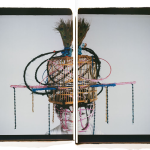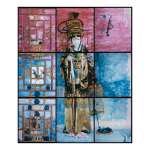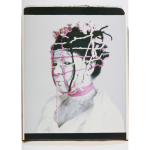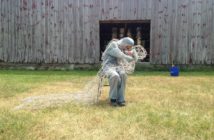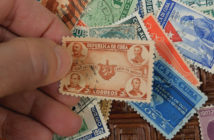Ben Sloat One theme that has always struck me about your work (and seen most recently My Mother Told Me at the Tufts University Art Gallery) is that of impermanence: the impermanence of history, the impermanence of one’s experience, but also the impermanence of a material. I think of this relating to other themes in your work, such as fragility or performance.
Maria Magdalena Campos-Pons I love your statement. It is a very good question; your reading of the work has so much accuracy. It’s true in a way, the idea of impermanence or the transient quality or the work what I refer to as the immateriality of the object is fundamental in my practice. I think it is profoundly linked to my own interest in the idea of memory and how memory has been a very important concept through the development of my work. It’s an incisive viewing of my practice because one of the things I’m most attracted to is a certain problematizing of the human condition and I’m trying to find ways to talk about them through visual material.
Ideas define my practice and then I try to find material and a way to use the body to construct those ideas into language. What you say about impermanence is very important because I am trying to define for me what is memory. This has to do with my own experience from being from many places, feeling the impermanence of home, which has been very important to my practice, but also trying to understand what that experience has been for others: not others in the generality of otherness, but what the experience has been for other people in my family, my village, people I have been close to.
You mention fragility, my work is all constructed out of fragments. Fragmentation is the expression of fragility made sturdy, kept together. The fragment, if you want to speak philosophically about it, is about pulling apart a component of the whole. When you take away a component of the whole, there is an immense vulnerability: it becomes more open to loss, to destruction, all of it. I’m talking about this as a metaphor, but an important metaphor.
When you take a fragment of the whole, it’s less secure, it’s less firm, it’s less powerful. In my work I’m trying to do that, when this whole is (in fragments) how do you make it resilient and sturdy and potent and complete?

MMCP Yes, I see my work as being filled with binary forces, it’s really constructed out of opposing ideas, opposing material, and opposing forces and polarities. I also think about the encounter of culture, the encounter of differences; as an artist who is working not only as a maker but as teacher, as an activist, working for other artists on their behalf, I am very interested in building and negotiating distance and disparities. I use it as a metaphor for negotiating differences and opportunities. In the work, that is very present.
I am very intrigued in my experience about the collapsing of expectations, the encounter, the juxtaposition and the hybridity of the culture from which I was formed as a young woman. When came to America, I was 27 years old, so already I had a lot things solidified in my thinking, not that I was not open to new things, but my own heritage is full of those opposites that are trying to coexist together. In the specificity of the work I am very attracted in juxtaposing time and modes of existence with technology and methodologies.
I am interested in the beauty of the technology seen by different eyes, by different cultures. At the center of my work, in the core of all of my ideas, I am a total and profound believer that if we drop text, the spoken language and we try to find ways to communicate together through material, through symbol, through gesture, immediately we can talk to each other!
So, for example, I am very curious about the birdcage. How is the birdcage made in Africa? How is it made in Guatemala? How is it made in China? Because they all functionally do the same thing, capturing a bird. That kind of commonality, that is from the essential thing of expressing life and surviving, and moving forward, and evolving. That is fundamental. I center my work in trying to understand those particularities.
The piece in Venice, which I used birdcages from Italy, is essentially about freedom and what the cage means in any place, any culture. It’s the entrapments and liberation of a particular being, in this case, the bird. You trap the bird, as the emperor did, for his own pleasure, disregarding the own pleasure/needs of the bird. I was determined in that piece to use a sort of naked technology. There are so many ways to use video, so many ways to play with the material in its own materiality.
My first approach to video was using it as a painterly material. You’ve seen one of the pieces in the show here at Tufts, Spoken Softly With Mama, where I throw video on the surface of the ironing board, I thought of it as a glazing. When you paint, you throw a layer to enhance or reduce colors on the surface, this video is almost like that. But in Venice, I thought of the video as a little luminous force trying to break the entrapment of the cage.

BS But it was about also a community of those birdcages together, a series, a construction where they became a kind of a village.
MMCP It is a village, it’s architecture. It’s a kind of scaled down version of Manhattan, or Havana, or Canton, or Venice. I was trying to create the idea of a series of islands. Doing the piece was very interesting there because of the constraints we needed to work with. I had these walls next to me in the building, which I couldn’t touch because of the history, I’m hoping to have the piece reinstalled in a more expansive space. I dream of a Kunstalle space or Turbine Hall at the Tate which is an expansive layout. Architecture was fundamental in that piece, that whole idea of the vertical city, but also the idea of accumulation, of fragmentation. The pieces are all made out of fragments, one birdcage at a time, times hundreds create this village.
BS Back to the idea of fragmentation, I’m interested how one piece by itself is vulnerable, but its accumulation creates a structure, a patterning, a whole other generative shape with a new meaning. In Spoken Softly With Mama, for example, the patterning of the cast glass irons on the ground creates a template of a Yoruban necklace, but also becomes a physical obstacle to the video pieces. My friend Raul commented to me about how the irons in that piece become like leg irons, the iron for the hand becomes a trap for the leg. You can’t move. Along these lines, another thing I want to ask about is how your materials relate to the body: they relate to the body of the viewer, to you the performer, to the suggested bodies in the works. Could you talk about that relationship?
MMCP It all departs from the body. That piece in particular, Spoken Softly With Mama, It was conceived as an homage to the bodies that were not there. Forcing the bodies that are observing to experience and to participate in a way they have never dreamed of. I talk about that with a sense of delight and revenge!
The story behind it is the incredibly skewed silent work of the women who were servants. These women who were extraordinary and beautiful and elegant and poised, but they were relegated to do the work to let other women become elegant while they were always behind the scenes, hidden. I put so much attention how to reverse that dynamic that they can become powerful and command attention and make you feel awe.
The first thing was to render a material or a object out of its own practicality. So the iron, which is made out of iron, was cast out of glass. But glass is the crystal, the elegant material that they needed to wash and clean for the house that they served. The boards are covered with silk, very good silk, I put a lot of attention into the material. The folded sheets in the pile behind the viewer of that piece are the highest quality, it was all important for the reading of the piece. The body is not there, but when you look at the folded sheets that have all been ironed by hand, the body is there.
When I grew up in Cuba, I couldn’t send anything to be dry cleaned, the dry cleaner was my mother! To the body, I remember as a very young kid holding my mother’s hand and finding a callous, "what is that, mama?" and she would tell me it was from washing on the washing board.
So I wanted to put the body there in the work, I do it in many ways. One is from making a shimmering pattern of the iron, which, when they are on a reflective floor, look like starlight. The boards are larger than you or as big as you. There is a presence of the boards that intimidate the body, it creates a dynamic of scale.
BS Thinking of the body and the embedded sense of work in the material, I’m always struck by the large format Polaroids. Each of those 20"x24" Polaroids takes hours to produce, and one of your new pieces is comprised of 21 of those! How did you come use that process?
MMCP When I studied at Mass College of Art in 1988, I studied in the Interrelated Media Program, I have a wonderful memory of that program. I was introduced to the Polaroid and its technician at that time. The entire process of using that camera never left my mind: it was a single shot, it was incredibly luscious, has a quality I have not found in another other photography technology, and it reminded me of Cuba. We still have, in the street, the people taking your instant photograph in the park. I still have that memory.
In 1991, I did a color photograph in Canada called Umbilical Cord. Jeffrey Keogh, the director of the Mass Art galleries at that time, he saw that piece when it was in the New Museum and asked me to do a project.
I came and started thinking about what to do with the camera, I had been very interested in performance and I saw the possibility of the process where you could see the film in a few minutes, then work it again and perfect it. I was very curious about the possibility of being myself, a body, in a performance capacity, and pair that with the performative quality of the Polaroid; it allowed an impermanence, an instant of observing and having a referent of what you have.
Polaroid has a material, a viscosity, but as a technology it is a very important step to the digital, but it put the seed to the idea of reproduction immediacy. You do it, you have it. I would like one day to see a conversation about that, the proximity of Polaroid to digital. I have been working primarily for the last ten or fifteen years with Polaroid in New York.
BS Over your career thus far, I wonder if you could talk about how your visual language has changed, what aspects of the work you think have transformed or were unexpected when you encountered the work at a later date?

MMCP One of the most enriching experience of having a 20 year survey of my work (at the Indianapolis Museum of Art in 2007), was to walk into the Museum and see connections and links that were invisible to my eye before. As a maker we are so involved in the process and barely have the distance to see. I found a consistency in my practice. The most revealing for me is what I consider my determination to take risks, to not conform myself to a formula of a successful project.
I started my career as a painter, my first international recognition came in a painting prize from France, but I was always an avid consumer of media. Film is a back bone in my practice and I see film as a big influence and paradigm in my work, even when I have not yet do a film per se. Performative practice and spirituality as driving forces are strong developments that sort of caught me by surprise.
There is a sort of delicate bravado in work that had never abandon my practice, one of my recent pieces is mixed media on paper and titled The Warrior Reservoir. I think it summarizes what I am at this moment.
Thank you for the questions. Very insightful and provocative, and it was such a pleasure to talk with you.
- The House, 2013 composition of 2 24×20 inches polaroids overall size 29 x 46 inches Courtesy of the artist and Stephan Stoyanov Gallery.
- The Flag. Color Code Venice 13, 2013 composition of 9 24 x 20 inches Polaroids overall size 87 x 69 inches Courtesy of the artist and Stephan Stoyanov Gallery.
- Freedom Trap 3, 2013 24 x 20 inches Polaroid Courtesy of the artist and Stephan Stoyanov Gallery.
Maria Magdalena Campos-Pons: My Mother Told Me is on view at Tufts through December 8, 2013.
Campos-Pons will be lecturing at Tufts on Nov 12, 2013 at 6 PM.\


